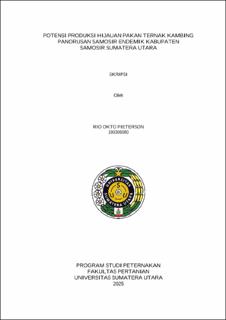| dc.description.abstract | The Panorusan Samosir goat has quite high potential, especially in terms of culture, so its conservation and development needs to be supported, in line with geographical conditions and the cultural wisdom of the local community. One factor that can support its development is in terms of forage. This research aims to determine the production of forage for Panorusan Samosir goats and their carrying capacity in Samosir Regency. The assessment of forage for Panorusan Samosir goats on pastures in Samosir Regency includes determining research location points, taking forage samples, then calculating forage production and carrying capacity. The research was carried out in three sub-districts with the highest population of Panorusan Goats in Samosir district, namely in Pangururan sub-district, Palipi sub-district and Simanindo sub-district. There are 15 research locations, where in Pangururan sub-district there are 5 research locations, in Palipi sub-district there are 5 research locations, and in Simanindo sub-district there are 5 research locations. The results of the research show that the types of forage that Panorusan Samosir goats prefer are Mimosa pigra, Tithonia diversifolia, Mimosa pudica, Ageratum conizoides, Cyperus rotundus L, Calliandra calothyrsus, Leucaena leucocephala, and Gliricidiasepium. The average production of fresh ingredients (BS) in Pangururan sub-district is 1,998.40 kg/ha, Palipi sub-district is 1,915.00 kg/ha and Simanindo sub-district is 1,891.80 kg/ha. The average dry matter (DM) production in Pangururan sub-district was 960.90 kg/ha, Palipi sub-district was 794.10 kg/ha and Simanindo sub-district was 775.60 kg/ha. The carrying capacity in Pangururan sub-district is 1.60 ST/ha/year, Palipi sub-district is 1.53 ST/ha/year and Simanindo sub-district is 1.51 ST/ha/year. The conclusion is that Panorusan Goat forage production and carrying capacity in Samosir Regency are relatively low. | en_US |


